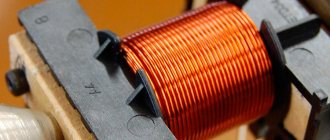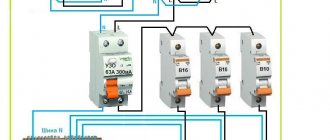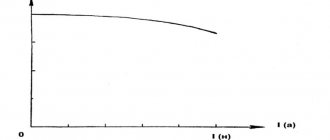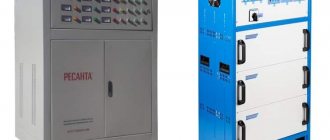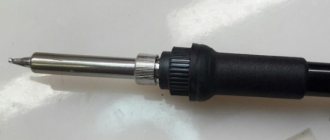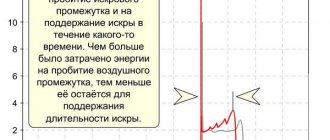Relay voltage stabilizer device
The heart of any relay stabilizer is an ordinary autotransformer; we have already written about it in some detail; by clicking on the link you can find out what it is and how it works.
Now it’s worth saying that the autotransformer has several taps - taps from the winding, each of which forms a secondary winding, with a different transformation ratio of the incoming voltage. In this way, the voltage can increase or decrease, and we will look at how this works below.
In addition to the automatic transformer, another important part of any relay stabilizer is the control board. It contains a number of components and solutions, in particular a voltmeter that measures the incoming voltage and control circuits that are responsible for switching the stabilizer modes.
Power relays directly switch the corresponding taps of the secondary winding of the autotransformer with the output contacts of the stabilizer.
A relay is a kind of circuit breaker; based on a signal, it mechanically closes or opens an electrical circuit. Depending on the model of the device, the number of such relays - stabilization stages, as well as their type, may vary.
In addition to the above, any electronic relay stabilizer also has fuses, indicators and other components on board, but we will not describe them; their type and quantity can vary greatly depending on the model of a particular device.
Now, to better understand how it works, let's look at its diagram.
The principle of operation of the voltage stabilizer and its design
At the heart of many voltage stabilizers is a high-power transformer, which helps the entire system operate. Based on the method of current regulation and other features of the products, two categories of equipment can be distinguished: electromechanical and electronic.
Electromechanical stabilizers are considered servomotors. The main control element analyzes the incoming currents, and based on the value, it begins to change it, the servo drive turns at a certain angle. If the position of the drive changes, the carriage on it begins to move the brush on the transformer winding. Which allows you to change the output current.
Electronic devices work a little differently. The incoming current that comes to the board is taken into account, after which the secondary winding section begins to be turned on or off. Switching is performed via a relay or using semiconductor switches.
The transformerless circuit is characterized by the use of an inverter stabilizer. The alternating current that enters the device begins to move through a frequency filter. After this, through a rectifier and correctors, it is converted to constant and stored in capacitors. Subsequently, the current goes to the inverter and generator, which make it possible to transform alternating currents with almost ideal values.
Operating principle of a relay voltage stabilizer
First of all, the incoming voltage is measured in the stabilizer, then, depending on the results obtained, a signal is sent from the control board to open one or another relay, respectively, the electric current from one of the taps of the autotransformer, reduced or increased to the desired value, is supplied to the terminals of the stabilizer , to the consumer.
To fully understand the principle of operation of a relay stabilizer, you should definitely know about the operation of the autotransformer and its structure, if you have not yet read our article about it - now is the time to do so by following the link.
As an example of how a stabilizer works, let's assume that each tap of the autotransformer gives +/- 15 Volts of voltage change, it works as follows:
— If the voltage in the network is 220V , it is immediately transmitted to the consumer, the transformation ratio is 1. Accordingly, in the range from 205V to 235V (220V +/-15V), the voltage to the output of the stabilizer will be transmitted without changes.
— As soon as the incoming voltage drops to a value less than 205 Volts , the first secondary winding of the autotransformer is activated, with a transformation ratio of 1.075, thereby again producing 220 V (205 * 1.075) at the output. At this moment, the relay responsible for this tap of the autotransformer closes, releasing current to the output contacts of the stabilizer, and all others open.
Further, until the voltage drops another 15V i.e. up to 190V (205V-15V), this secondary winding will continue to operate with the same transformation ratio, thus, if the network voltage drops to 196V (switching limit to the next mode), the output is 211V (196 * 1.075).
— When the incoming voltage drops below 190V , the next relay is triggered, and the previous one opens, thereby turning on the next secondary winding of the automatic transformer, with a transformation ratio of 1.15 and the output voltage again becomes 220V (196 * 1.15) and so on, every 15V the winding switches to, say, 145V - after which the stabilizer goes into protection.
- If, on the contrary, the voltage in the network increases above 235V , using the appropriate relay, the step-down secondary winding is activated, with a transformation ratio of 0.94, and again the voltage in the network is equalized to the required 220V (235 * 0.94).
I think that now the principle of operation of a relay stabilizer is clear to you, now let’s look at what strengths and weaknesses a stabilizer of this type has, and in what areas it is best used.
Voltage regulator. Types and work. Application and how to choose
In the life of a modern person there are many electrical appliances that he constantly uses both at home and at work. There are consumers who require maintaining voltage within strict limits and to achieve this, it is necessary to use a voltage stabilizer.
Kinds
Depending on the technical solution, stabilizers can be of several types:
- Relay . They provide step adjustment and consist of an autotransformer and a power relay. Such devices cannot regulate the output voltage with high accuracy. To improve the quality of stabilization, the design of the autotransformer is complicated, but this leads to an increase in the cost of the equipment. Such stabilizers are used with low-power devices.
- Triac . These are electronic devices that operate on the relay principle, but the windings in them are switched by triacs (electronic keys). Since there is no mechanical relay, the switching speed increases, they are more reliable, operate quieter, but also cannot provide high accuracy of the output voltage.
- Electromechanical or servo driven . They operate on the principle of a rheostat (an electric drive moves contacts along the winding of an autotransformer), so they can smoothly change the output voltage. Such equipment can be used in networks where there are no sudden voltage surges.
- Ferroresonant . This equipment continuously regulates the output voltage within a specified range. This option has a number of unsolved problems, so its use is limited.
- Inverter . These are the most modern stabilizers that work on the principle of double voltage conversion: first it is converted from AC to DC, and then again from DC to AC. In this case, there is no bulky transformer, so such devices are small in size and weight. This equipment has high accuracy, it is within 1%. Regardless of the input voltage, we get an almost ideal 220 V at the output.
How does the stabilizer work?
The voltage stabilizer consists of several main parts that are found in such equipment, regardless of its type:
- Autotransformer. It can have an aluminum winding, used in cheap models, and a copper winding, used in high-quality devices.
- Electronic control circuit. It will be different for different brands, so a voltage stabilizer of the same type, but from different manufacturers, will perform its functions differently. The difference lies in the key closure algorithm, so devices of identical type have significant differences in operation.
- Closing keys. These elements of the stabilizer determine the type of its communication: electronic or electromechanical. Electronic stabilizers are more preferable, since their response speed is within 10-20 ms, while for electromechanical ones it will be 40-50 ms.
- Elements of protection. The main ones include thermal and magnetic releases, and additional ones include lightning protection.
- Bypass is a device that ensures continuity of power and connects directly to the network.
Operating principle
The principle of operation of the equipment is based on monitoring the incoming voltage and adjusting it at the output, depending on the changes that occur.
When a voltage change occurs at the input, the stabilizer spends some time taking measurements. In electronic models this requires up to 20 ms, and in electromechanical models up to 50 ms. At the next stage of work, an appropriate reaction to the situation occurs. All voltage changes are equalized to 220 V.
When the input indicators decrease, the voltage stabilizer raises its input indicators as far as the capabilities of the autotransformer are sufficient. When the input values exceed the specified range, the device automatically turns off the voltage supply. The voltage stabilizer does not allow pulse surges to pass through to the connected equipment.
The voltage is regulated by connecting additional windings of the transformer using switches, which can be electronic or relay. The switching process is controlled by a processor, which does not allow more than one key to be turned on at the same time.
Application area
Voltage stabilizers are widely used both in industry and in everyday life. Unstable voltage in the network makes the use of such equipment very relevant.
Everyone in their home has such expensive equipment as a computer, washing machine, refrigerator and other equipment for which high-quality power supply is very important. An optimal and inexpensive solution that allows you to reliably protect household appliances and various industrial equipment is a voltage stabilizer.
Low or high voltage, as well as its peak surges, can lead to failure or unstable operation of various household appliances. The presence of a stabilizer allows you to equalize the resulting voltage drops; at the output it produces the rated voltage, which is necessary for the correct operation of the connected electrical equipment.
How to choose a voltage stabilizer
To make the right choice, experts recommend paying attention to the following features:
- Installation method, the stabilizer can be installed next to the device being serviced, stationary devices are mounted on the wall in a horizontal or vertical position.
- If a 220 V device is used, then the accuracy of its operation should be 1-3%.
- Power, you need to purchase a device whose power will be 30% greater than the power of the connected equipment.
- There can be single and three-phase stabilizers.
- The performance of the device is measured in milliseconds.
- The presence of protection, this function will protect the device from short circuits, sudden voltage surges and other negative aspects.
- The size of the equipment, as well as the noise level it produces during operation, also matter.
- Cost, a high-quality device cannot be cheap; it is better to purchase more expensive, but high-quality equipment.
- The service life is guaranteed; a high-quality stabilizer will have it for several years, while cheap models may not have any guarantees at all.
If equipment with a powerful electric motor is connected, then the reactive component of power must be taken into account, since when the motor is started, the current increases greatly and if this parameter is not taken into account, the stabilizer will not be able to cope with the load that occurs when the electric motor is started.
Advantages and disadvantages
The advantages and disadvantages of such devices will depend on their type:
- Relay. The main advantage of a relay stabilizer is the high speed of voltage regulation. The disadvantages of such devices are that the voltage changes in steps, the stabilization accuracy is low and the sinusoid is distorted.
- Triac. The advantages are that during operation they have a low noise level, the switching process is fast, and the voltage change occurs smoothly. Their main drawback is the low accuracy of voltage regulation.
- Servo driven. Such stabilizers smoothly regulate output parameters, do not distort the sine wave and provide high control accuracy. The disadvantages of such equipment are the low reaction speed and low speed of regulation, and the presence of mechanically moved parts reduces the reliability of such devices.
- Ferroresonant. This equipment provides high speed and accuracy of stabilization. It has a long service life and high reliability. The disadvantage of such stabilizers is that the sinusoid is distorted, they have a small adjustment range, they are heavy and the efficiency is only 70-80%. In addition, operation of such equipment under heavy overloads and in idling mode is not allowed.
- Inverter. They provide high accuracy and speed of adjustment, and can work with both very low and high input voltages. Such devices can operate without load, suppress impulses and interference, and create the correct sine wave. Their main disadvantages are low efficiency, difficulty of repair and high cost.
The service life of electrical appliances and the quality of their work will depend on the parameters of the supplied electricity. To protect equipment from changes in network voltage and ensure its reliable and long-term operation, it is enough to install a modern voltage stabilizer.
Related topics:
- Uninterruptible power supply (UPS). Kinds. Job. How to choose
- Electric generators. Kinds. Device. Application. How to choose
Advantages
Low cost
It is precisely because of their low price, relative to other types of stabilizers, that relay models are so popular. At the same time, in other respects, they completely cover the needs of the modern consumer in most cases.
Quite fast stabilization speed, on average 5-30 ms
Relay stabilizers react to changes in incoming voltage at high speed, and allow you to protect your electrical equipment even during sudden drops or surges
Simplicity and maintainability
Possessing a simple, understandable architecture, relay stabilizers do not have a mass of complex components that could fail. There are not many possible problems and all of them have been studied and described, are easily diagnosed and can be corrected at home, even if you have only superficial knowledge and skills in electrical repair.
Flaws
When switching frequently, power relays fail
One of the most significant disadvantages of relay stabilizers, in my opinion, is the possibility of failure of power relays if mode switching occurs quite often and intensively. Contacts oxidize over time or can burn at high currents, which greatly reduces the service life of the relay.
Clicking when switching relays
Another feature that can become a serious drawback if the relay stabilizer is installed somewhere near you is the sound of the relay switching, which clicks quite loudly.
Relatively high stabilization error, on average about 5-8%
Depending on the number of taps from the autotransformer - secondary windings and, accordingly, the number of relays in the circuit, the relay stabilizer has a degree of stabilization error, on average 5-8%, and this is quite a lot. As you can see from the calculations presented above, the stages at which stabilization occurs are within 15 Volts, which is equal to 6.8% of 220V; particularly sensitive electrical appliances can react to such indicators.
If you require normalization with greater accuracy, be sure to consider electromechanical voltage stabilizers.
Short-term interruption of current supply at the moment of relay switching
When switching a relay, during a change of modes, for a very short time, the current supply is interrupted when the contacts of one relay are already broken, and the second is just closing. In this case, a surge or voltage surge often occurs. This can have a negative effect on particularly sensitive electronic components and can also be reflected, for example, in a short-term change in the brightness of the lamps.
Power drop at low voltage
Relay stabilizers produce the full power declared by the manufacturer only in a fairly narrow range of incoming voltages, often only up to 190 Volts, then the performance rapidly drops and at some point reaches only 40-50% of the nominal.
Which voltage stabilizer to choose
Voltage stabilizers should be selected based on the tasks that the equipment will perform. Experts advise paying attention to the following parameters before purchasing:
- A relay or inverter device with a power of 0.5 kVA can protect a computer or TV from surges.
- Electromechanical devices with different powers, depending on the technology, will be suitable for a summer house where there are no valuable household appliances.
- Combined 10 kVA models are recommended to be installed in a country house or apartment to power a large amount of equipment.
- Electromechanical options for 15 kVA with 3 phases are an excellent choice for a country house where a 380V network is used.
- A thyristor or relay type of 1 kVA or less is recommended for a boiler intended for gas-fired heating.
It is also necessary to take into account that electromechanical options are not used for boilers, since the brushes will spark when in contact with the transformer, which increases the risk of fire. Having studied all the features, any person with problems in the electrical network of his home will be able to choose the right stabilizer for one piece of equipment or all equipment.
Where are relay stabilizers used?
If we analyze all the pros and cons of a relay stabilizer, we can conclude that it can cope with most household tasks. Almost everywhere where precision stabilization is not required, but high speed is required, a relay stabilizer is simply irreplaceable.
In particular, relay stabilizers are actively purchased to equalize voltage in an apartment or country house, as well as in a garage. In addition, almost any household appliance that has a motor or heating element, for example, a refrigerator, washing machine, dishwasher, or power tool, works great with inexpensive and fast relay stabilizers.
When voltage drops or, conversely, power surges do not occur very often, but still happen during the day, for example, in a gardening community, where the voltage in the network often strongly depends on what your neighbors are doing at the moment, depending on this it can change rapidly, a relay stabilizer is the optimal solution.
If you have some kind of equipment that is sensitive to even the slightest voltage surges or electric current parameters, as well as to the accuracy of stabilization, for example, a high-quality audio amplifier, you should choose a different type of normalizer.
Basic parameters for choosing a voltage stabilizer
Many models of voltage stabilizers are suitable for home use. To make an accurate choice, it is important to determine several factors. Initially, you should understand the equipment that will be connected, the area of use (private house, apartment or cottage).
Phasing
Buyers are often faced with the problem of phases of the device, because there are models for 3 or 1 phase. This question arises more often among people who use a three-phase network, since if there is a single-phase system, the choice will be obvious. In the first case, you can use single-phase devices to prevent shutdowns of the entire system in the event of a loss of current in one of the phases.
Ideally, it is recommended to install 1 stabilizer on each phase, which will be cheaper than purchasing one three-phase model. The last option can only be useful if at least 1 three-phase consumer is installed in the house.
Power
You can choose the right unit only based on the power of all the equipment that will be connected to the stabilizer. To do this, you need to add up all the amounts, and the final value can be 3-4 times greater than the total power. Any manufacturer of stabilizers provides a passport for the device, which indicates the power.
Stabilized voltage range
Any type of technique described is used exclusively for converting current within certain limits. For example, the range for domestic conditions is 130-270V. If the indicator goes beyond the limits, all devices in the house connected to the stabilizer will turn off.
It will only take a few days to make an accurate calculation of the range. To do this, you need to analyze the indicators for several days during peak load hours. As a result, the necessary calculation is made, equipment is selected that will fully satisfy the needs in terms of technical parameters.
Stabilization accuracy
For optimal protection of household appliances, when choosing a stabilizer, it is necessary to take into account the maximum range of differences that need to be protected. If the technique is used for lighting equipment, then the accuracy should be from 3%. This makes it possible to eliminate the flickering of light bulbs, even in the event of a sudden change in current in the network. Many appliances for home use are able to function normally with changes in the electrical network in the region of 5-7%.
Installation method
The choice of installation depends on personal preference. All stabilizers are installed on the floor or walls. When choosing a location, you should take into account the small amount of space that will be required for cooling and fan operation.
One or more stabilizers?
It is best to use a separate stabilizer for each device for reliable protection against power surges. The choice is made based on power and accuracy. To save money, it is recommended to connect several electrical consumers to one unit at once, calculating the total power. In this case, stabilization can be carried out for expensive and important equipment, and all other types of devices that have optimal protection or are not sensitive to voltage surges will remain without connection to the stabilizer.
The best relay voltage stabilizers
Currently, there are quite a lot of players in the stabilizer market, large and small manufacturers, each with several lines of models, with different output power and functions, so it is not easy to name any specific successful products.
But of course, by studying the experience and reviews of our colleagues, suppliers and clients, we can identify several of the most optimal manufacturers in various categories of consumer properties, using the example of 5 kW - kVA models in particular:
ENTRY LEVEL
Of the most affordable, inexpensive , but at the same time quite high-quality relay voltage stabilizers, I advise you to take a closer look at the models of the following manufacturers: Resanta Quattro Elementi. These stabilizers are used especially successfully in the country house, garden plot or garage, as well as when powering household appliances or power tools.
Stabilizers from these manufacturers are often installed in apartments and cottages, boiler rooms and other places where reliability is important, both in stabilizing and protecting electrical appliances from the negative effects of poor-quality electrical current parameters.
Inexpensive and high-quality relay stabilizer RESANTA ACH-5000/1-C (~ 5400 rubles)
Quattro elementi stabilia 5000 - Another affordable relay stabilizer with good reviews (~6000 rubles)
MORE..
PRICE QUALITY
In terms of price/quality ratio , with an emphasis on reliability, quality and functions, such as a wider range of stabilization, additional protection and filters, the most interesting manufacturers of relay stabilizers, according to a large number of consumers, are: Energy and Rucelf of the following models:
One of the most successful models of relay stabilizers, combines affordable cost and high reliability RUCELF StAR-5000 (6500 rubles)
Energy ACH 5000 is a Russian-made relay stabilizer, in a compact, portable design, 7 stages of stabilization. (~7000 rubles)
ADVANCED MODELS
The most expensive and advanced relay stabilizers, with the maximum number of options, a high degree of stabilization and other high-level characteristics, which are designed for installation in more critical places that are demanding in terms of quality, reliability and accuracy of voltage parameters, for example, in production, in cafes, shops and etc. produced by manufacturers: Lider, Energy, Uniel
Energy Voltron 5000 is a professional high-quality relay voltage stabilizer, with very good characteristics and additional functions. (~9000 rubles)
Uniel-rs-1-5000ls - relay stabilizer with the widest stabilization range, high response speed, its characteristics are compared with ... (~ 12,000 rubles)
If you know other worthy manufacturers or successful models of relay stabilizers, be sure to write in the comments to the article. In addition, ask questions, and if you have comments or criticism, express them.
If you think that a relay device is not what you are looking for, be sure to study the features of stabilizers of other types and read reviews of models for different typical cases, all this and much more awaits you in upcoming articles, follow the release of new materials, subscribe to our VKontakte group.
Why do you need a voltage stabilizer, its functions
Voltage stabilizers absorb all fluctuations in the electrical network, “dampen” the surge and produce a smooth current at the output, thereby protecting home appliances from failures and breakdowns.
If you are not Superman, then it is better not to tame lightning, but to buy a stabilizer for your electrical network
So, what benefits will you get if you install this device:
- Your electrical appliances are guaranteed to be “powered” from the network for which they are designed. This will extend their service life and save your money and nerves.
- Any power surges will not affect your network, even if lightning strikes your house.
If you often encounter power surges in the network, check the power of your appliances; it is quite possible that your network (or rather, the transformer) is simply not designed for such loads.
For your home, you can choose either a portable stabilizer or a stationary, more powerful one.

